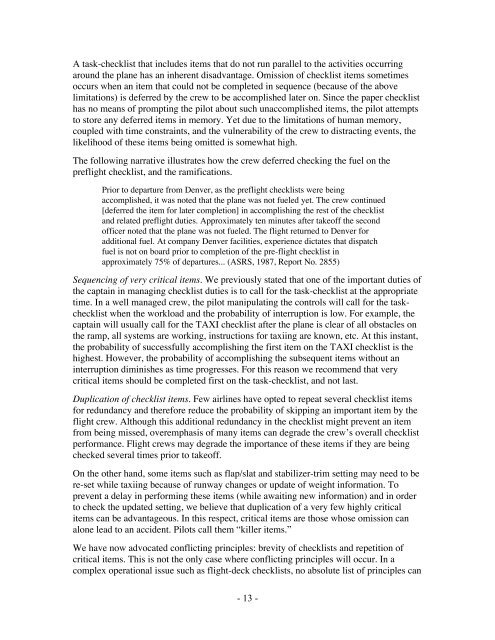COCKPIT CHECKLISTS: CONCEPTS, DESIGN, AND USE - NASA
COCKPIT CHECKLISTS: CONCEPTS, DESIGN, AND USE - NASA
COCKPIT CHECKLISTS: CONCEPTS, DESIGN, AND USE - NASA
Create successful ePaper yourself
Turn your PDF publications into a flip-book with our unique Google optimized e-Paper software.
A task-checklist that includes items that do not run parallel to the activities occurringaround the plane has an inherent disadvantage. Omission of checklist items sometimesoccurs when an item that could not be completed in sequence (because of the abovelimitations) is deferred by the crew to be accomplished later on. Since the paper checklisthas no means of prompting the pilot about such unaccomplished items, the pilot attemptsto store any deferred items in memory. Yet due to the limitations of human memory,coupled with time constraints, and the vulnerability of the crew to distracting events, thelikelihood of these items being omitted is somewhat high.The following narrative illustrates how the crew deferred checking the fuel on thepreflight checklist, and the ramifications.Prior to departure from Denver, as the preflight checklists were beingaccomplished, it was noted that the plane was not fueled yet. The crew continued[deferred the item for later completion] in accomplishing the rest of the checklistand related preflight duties. Approximately ten minutes after takeoff the secondofficer noted that the plane was not fueled. The flight returned to Denver foradditional fuel. At company Denver facilities, experience dictates that dispatchfuel is not on board prior to completion of the pre-flight checklist inapproximately 75% of departures... (ASRS, 1987, Report No. 2855)Sequencing of very critical items. We previously stated that one of the important duties ofthe captain in managing checklist duties is to call for the task-checklist at the appropriatetime. In a well managed crew, the pilot manipulating the controls will call for the taskchecklistwhen the workload and the probability of interruption is low. For example, thecaptain will usually call for the TAXI checklist after the plane is clear of all obstacles onthe ramp, all systems are working, instructions for taxiing are known, etc. At this instant,the probability of successfully accomplishing the first item on the TAXI checklist is thehighest. However, the probability of accomplishing the subsequent items without aninterruption diminishes as time progresses. For this reason we recommend that verycritical items should be completed first on the task-checklist, and not last.Duplication of checklist items. Few airlines have opted to repeat several checklist itemsfor redundancy and therefore reduce the probability of skipping an important item by theflight crew. Although this additional redundancy in the checklist might prevent an itemfrom being missed, overemphasis of many items can degrade the crew’s overall checklistperformance. Flight crews may degrade the importance of these items if they are beingchecked several times prior to takeoff.On the other hand, some items such as flap/slat and stabilizer-trim setting may need to bere-set while taxiing because of runway changes or update of weight information. Toprevent a delay in performing these items (while awaiting new information) and in orderto check the updated setting, we believe that duplication of a very few highly criticalitems can be advantageous. In this respect, critical items are those whose omission canalone lead to an accident. Pilots call them “killer items.”We have now advocated conflicting principles: brevity of checklists and repetition ofcritical items. This is not the only case where conflicting principles will occur. In acomplex operational issue such as flight-deck checklists, no absolute list of principles can- 13 -
















